Abstract
Communication is one of the elemental aspects of management and operation in any organization and projects. The significance of communication can never be exaggerated. Communication eliminates misunderstandings, confusion and misrepresentation thus establishing harmonization among all the subordinates and departments. Communication is necessary to handle business operations at all levels.
There is no doubt that supervisors and managers need to master in communication because without its support decision-making will not be effective, problems among manager-employee relations will raise and the employees will act upon their own analysis and understanding that would eventually disturb the whole business culture of an organization. There are two types of communication, verbal and non-verbal communication and both of them have their own recognition within a workplace.
Communication facilitates to increase the level of productivity, minimizes defensiveness and maximizes openness and creativity, ultimately increasing corporate performance. It also increases the morale of employees. The present study aims to investigate the level of communication at workplaces, and how it helps to improve the understanding between the employer and the employees within the organization.
The methodology adopted in this study is quantitative and uses descriptive analysis to predict the relationship between communication and corporate as well as employees performance within an organization and projects. The findings suggest that there is a positive relationship between the affect of communication and corporate performance. Moreover, it also highlights that the positive perceptions regarding communication within organizations has positive impact on employees’ performance.
Introduction
Background to Context
Communication is a method by which people interchange information through a general process of signs, actions or symbols. Communication is one of the most imperative tools introduced in every organization to appropriately execute the operations and procedures within the organization. Every organization has its own set of communication techniques, and is managed according to the internal environment of the company.
The apposite execution of communication also helps to solve conflicts and unsettled transactions. Today, a number of communication models and techniques are applied in the corporate world and are based according to the company’s environment. Communication is an important means to verify the employee’s performance. Communication is considered as the strong foundation of a team where the personnel can work well according to the company’s established plans (Dalton and Hoyle 2009). Communication also helps to accomplish the projects more accurately and quickly.
The importance of communication at workplace evolved in the early twentieth century. According to W. Barnett (2008) the introduction of communication was described as “revolutionary discovery” that was mainly started due to increase in communication technologies such as television, radio, cellular phones, landline phones and Internet. After the World War II the world was moving towards technological era, and was improving the society by minimizing tyranny and rivalry between the nations as well as fostering capitalism.
At that phase communication played a vital role and became fundamental to concerns such as public relations and interactions. Decision-making and persuasion was also an imperative concern raised particularly in organizations, thus communication became a distinct discipline and was implemented effectively in every organization (Foss and Littlejohn 2008).
There were three basic approaches due to which communication process evolved; those three approaches were Classical Approach, Bureaucratic Approach and Scientific Management Approach. In the classical and scientific approach Fayol, Weber and Taylor (Miller 2009) suggested three theories. These three theories were based upon organizational structure and revolved around power or authority, individual attitude and work design. These theories suggested machinelike workplace environment, there were no interactions or associations between the employers and employees. Decision-making was only dependent upon the employer. In the classical approach the communication flow and communication task was extremely narrow (Miller 2009).
In every organization setting there are three main types of communication. First is task-related communication in which the employee only focuses upon tasks or goals of the organization, but has no right to consider their individual desires or wants. Second, innovation-related communication is in which the employers take suggestions from their employees about new and innovative ideas. Third is maintenance-related communication that emphasizes upon human relations and exchange of ideas on social topics within an organization that basically encourage interaction and respect for each other. In classical, bureaucratic and scientific approach, only task-related communication was supported, rest of the two was ignored (Miller 2009).
Another way to characterize communication is through communication flow that describes how the message or information is streamed within the organization structure. Communication can flow in various directions, but the prominent ones are vertical flow, horizontal flow and free flow. In vertical flow, the communication is in the form of orders, laws and regulations that is directed from up-to-down flow, thus the employers pass orders to managers, managers to supervisors and then from supervisors to the subordinates and vice versa.
In horizontal flow, the communication is a little flexible and it allows the communication horizontally between the employees to managers and then to employers. In free-flow the communication is highly flexible and encouraging. It encourages the organizational personnel to talk with all the members of the firm without any hesitation. The theories of Fayol, Taylor and Weber (Miller 2009) considered the vertical flow of communication thus the level of feedback was low in such communication flow (Miller 2009).
After the failure of Classical, Bureaucratic and Scientific Management School of Thoughts in providing a model for communication, motivation and teamwork a new model was introduced which is known as Transactional Process Model of communication. It emphasized upon the effect of communication within the organization, and how it helps to build stronger employee-manager relations.
The hierarchal differences of bosses and workers were reinstated by more unbiased terms of sender and receivers. Furthermore, these terms brought a sense of motivation and morale into the employees, and formed an appreciation for how the personnel perform their tasks simultaneously. In the Transactional Process Model several aspects were highlighted such as: all the people at workplace would be affianced in sending and receiving messages, every person will be continuously influencing the other person thus building an association, feedback is also a vital element in this model and it would be in the nonverbal form. Moreover, any person receiving a message will be taken as a better source of meaning than a person sending a message (Goodall 2010).
Transaction Process Model is considered as one of the most dominant communication model at workplaces. It helped to advance human resources, human relations and human capability methods to management and organizations. The communication techniques evolved due to the transactional model. It facilitated the concept of verbal and non-verbal communication, and minimized the conception of top-down command and control business environment.
Transactional process model has enabled a useful approach for practices such as interpersonal communication, teamwork communication and leadership in the workplace. Thus this model has built an evolution of communication within the working environment of every organization and today, the communication is highly affecting the performance and employees and management (Goodall 2010).
Research Objectives
The main objective of the research is to form a comprehensive understanding of the importance of communication within the organizations, and to evaluate the effects of communication of employee performance
The sub objective of the research is to identify different ways of communication and impact of communication on financial performance of the organizations.
Research Aim
The research aim is to identify the level of communication at workplaces, and how it helps to improve the understanding between the employer and the employees within the organization. The research has tried to explain the importance of verbal and non-verbal communication and establish trends that are examined by applying them appropriately. The research is based upon the inclusive models depicting the effects of communication upon the internal environment of the workplace.
Mainly, the research focuses upon the basic elements of communication with the help of specific models, and how it helps to shape up the attitudes and behaviors of employees within the organization. In addition, it also highlights the latest communication techniques such as email communication, which is becoming highly popular and is being applied in well-known organizations.
Research Questions
The research questions set out for the study are to support the research hypotheses underlined for this study and they are addressed in this report by investigating different elements of communication model selected for this study:
- What are the key elements of communication?
- How verbal and non-verbal communication is helpful to enhance the perception of both employees and employers in the organization?
- What are the latest communication techniques being applied in the organizations?
- How communication can affect the employees’ performance?
- How communication can affect corporate performance?
Scope
The scope of the research is extensive as it covers different aspects of study of communication and how it affects the performance of employees and corporate within the organizations. The research not only provides a thorough theoretical and conceptual framework for such study but also incorporates primary research that provides first hand information on the performance trends observed amongst employees, and identifies importance of communication between the personnel.
However, the researcher did face difficulties in acquiring responses from the companies and these responses could also be argued to have elements of biasness. The research questions that are enlisted in the previous sections are not considered to be exhaustive and any other information that is deemed necessary for providing conclusions to the present study that are conclusive in nature is included in the report.
The conceptual framework designed for this study after careful review of the existing theories and previous studies on similar research topic lays out grounds for the study however this is also subject to the researchers own ability and understanding of relevant information.
Structure of Report
The research conducted by the researcher is presented in this report according to the following structural layout.
- Chapter 1: Introduction
- This chapter lays out grounds for the present study by providing detailed background to the context of this research. It also sets out objectives of the study along with the project aim. The research hypotheses that are tested out in this study are also provided with supporting research questions that are addressed through data collection using different research techniques. Finally, this chapter sets out the scope and significance of this study.
- Chapter 2: Literature Review
- This is perhaps the most important chapter that includes various theories governing communication within organizations and projects employee’s behaviour, attitude, awareness and perceptions towards communication. Previous studies that have been carried out on a similar research topic are also provided that assist in developing the conceptual framework for the present study.
- Chapter 3: Research Methodology
- This chapter entails various possible research approaches that are considered for carrying out the present study. From these approaches the present research methodology is derived along with the tools used for data collection. Furthermore, this chapter lays out the basis of analysis to draw important conclusions and test out the research hypotheses established for this study.
- Chapter 4: Findings and Analysis
- This chapter provides findings from the primary research that is conducted in the form of survey questionnaire. These findings are derived from the use of statistical tool selected for this research and are supported by tables and figures. Finally, these findings are analysed on the basis of the conceptual framework set out for the study.
- Chapter 5: Conclusions and Recommendations
- The final chapter in this report summarises the outcome of the research conducted and provides evidence supporting either of the two research hypotheses. Furthermore, this chapter makes recommendations for improving communication within organizations. Finally, recommendations for future possible studies are made.
Literature Review
Introduction
Communication is one of the fundamental aspects of management and operation in any organization and projects. The importance of communication can never be exaggerated. It affects the process of conveying the information, messages, ideas, perceptions, opinions and decisions between the individuals within the organization. Human relations cannot be achieved without communication.
However, effective communication is the primary element for effectual human relations and for successful business. Communication is essential at numerous levels and for numerous aspects in the organizations and it is effectual for completing the projects as well. In a manager-employee relation the exchange of information and decision is a basic element. The employees cannot perform effectively if the manager doesn’t communicate with his employees properly.
Communication also helps to provide motivation and enhance morale of the people working in the organization. Conflicts and low levels of morale are mainly caused due to faulty and improper communication between the manager and his subordinates. Moreover, communication also facilitates higher productivity and encourages the employees to suggest ideas and suggestions and applying those ideas whenever possible. Communication eliminates misunderstandings, confusion and falsification thus establishing synchronization among all the subordinates and departments (Thomson 2007).
In this chapter first of all the key aspects of communication has been explained thoroughly. Then the importance of verbal and non-verbal communication has been discussed followed by some of the main theories regarding communication. These theories basically highlight how the communication influences the performance of the workers, managers and the senior management within the organization and how it affects the projects. In addition the latest communication techniques that are being applied at workplace have also been discussed. This is presented in the form that it provides the conceptual framework for the methodology adopted and analysis of findings derived from the study.
Theoretical Framework
In order to develop a better understand of what are the effects of communication within the organization and projects, various theories have been suggested. These theories of communication belong to different areas of thoughts and provide a deeper knowledge of the trends and relations of employees and managers. Some of the theories applicable to the subject at hand are the following:
Key Elements of Communication within Organizations
Every organization follows basic elements of communication that are sender, receiver, message, channel, noise, feedback and context. All of these basic elements highly affect the environment of the organization. In every business the sender is considered as an originator or a basis of a message. In the older times, a boss or a senior manager was known as a sender in the organization. But today the concept has been changed. Now the messages are initiated from several sources, and at every level within every business (Goodall 2010).
In every organization the sender and the receiver both plays a vital role, every information or ideas that are transmitted between the sender and receiver highly influences the performance of corporation. The person who receives a message from a sender is known as a receiver. In the previous organizational models only the employees or workers were considered as receivers. They were not allowed to give any suggestions or messages to the managers or employees, but today the hierarchy style has been changed.
Everyone within the organization is a receiver and a sender at all levels (Goodall 2010). The message is referred as the information the sender passes to the receiver in the communication process at the workplace. Messages can be either verbal or non-verbal. The meaning of message is understood by examining both the verbal and non-verbal aspects of communication. For example, the tone, gestures, facial expressions and postures of a person all contributes to the understanding of a message.
Another important element that is considered under the effect of communication context is noise. “Noise can be physical, semantic and hierarchical that either shape or disrupt the interpretation of the messages” (Goodall 2010). There are three basic types of noises. First is Physical Noise in which, the message or communication is disrupted by a louder or sudden noise. For instance, a sudden announcement made during a conversation, or a loud noise coming from outside of the room. Second is Semantic Noise that explains the differences the people have for understanding the meaning of messages or words.
Semantic noises can be the cultural metaphors, gender biased words and misunderstood perceptions. Third is Hierarchical Noise that refers to the shadings in understanding we ascribe to a message depending upon a person’s position or eminence within an organization. For instance a customer will prefer to give a complaint to the customer service manager rather than to the customer service spokesperson, although a manager would direct the message back to the representative to solve the issue (Goodall 2010). All three types are of main concern in every organization today and it is crucial to control the affect of noise within the working environment.
Another imperative element of communication is providing feedbacks in the organizations. Since the last two decades feedback has become one of the common and most important facet of the workplace. Feedback is a mode of responses of communication given to the sender and receivers in the form ideas and identities. The basic goal of these feedbacks is to enhance employee development and progress organization’s performance.
The communication theorists consider feedback as the most fundamental element, for instance if a customer gives a smile this means that he or she acknowledges the facility and eminence of the work or product. The display of workplace also is a form of feedback, as it reflects the personality and interests of the people working in the organization. The timings of a message also have a massive effect upon the business communication (Goodall 2010). Pragmatic evidence recommends that giving feedbacks always lead to better end results in organizations, and improve self-esteem of the employees (Kuhnen 2010).
Cultural context is another imperative element, which should be considered in today’s working environment. The organizations are expanding globally creating cultural context. The different lifestyles, thoughts, perceptions and the backgrounds between the communicators matter a lot. Every organization represents diverse cultures and subcultures. From a perspective of communication, the cultural context creates collaborations, coordination and a shared sense of understanding between the subordinates (Goodall 2010).
Stanley Deetz Theory of Communication
The communications and interactions between co-workers and members of the organization is referred as employee-organizational communication. Organizational communication is very much similar to internal communication or internal relations. In 2001, Stanley Deetz a communication theorist highly emphasized upon internal communication. He described internal communication in two different ways.
His first approach states that internal communication is a phenomenon that subsists within organizations, which explains that organization is a box and the communication occurs in that box. His second approach explains internal communication as the central procedure through which the sub-ordinates and managers share information, build relationships, express ideas, give suggestions and construct organizational philosophy and principles. Internal communication is a process of individuals, messages, perceptions, practices and functions. It is the groundwork of progressive organizations (Berger 2008).
According to Deetz (2001), communication helps the employees and groups to coordinate and accomplish goals. It’s pivotal in decision-making, associations, problem-solving, feedback and change management processes. Internal communication is also an imperative facet of organizational change. It is the crucial feature for enhancing motivation, in taking initiatives and in making all the efforts to bring change or diversify.
Some theorists suggest that internal communication is one of the vital driving forces of business performance. Stanley also demonstrates that internal communication assists in maximizing employee’s morale, trust, efficiency, job satisfaction, commitment and learning. Furthermore, it also develops communication climate and interactions with publics and improves business quality, increases revenues and profits (Berger 2008).
Communication within the organization augments employees’ satisfaction, which eventually gets linked to job performance, job satisfaction, project productivity, organizational commitment and other substantial outcomes. According to studies (Berger 2008), Organizations engaged in effective communication and committed employment were almost 50 percent more prolific as compared to other organization where communication is not supported and employees aren’t engaged.
Deetz (2001) demonstrates communication as a fragmentary social construction of meaning, although he highlights that the matter of power runs through all the language process and communication. According to Stanley there are four main approaches regarding internal communication that affects the decision-making process within the organizations. First approach is Strategy, which explains that manager’s value has control over all else values.
The aspiration for control may surpass the aspiration for corporate performance. Strategic control has some drawbacks, as it provides no benefits to the corporation and makes rivalries among the employees. Second approach is Consent which is a variety of scenarios and methods in which some person actively, although unintentionally acquires the interest of others in the faulty effort to implement his or her desires. Third is Involvement that means openness in expressing ideas. It allows employees to share their grievances, desires and ideas and permits to suggest improvements. Fourth is Participation in which consequential democratic participation is supported that constructs better citizens and effective choices thus enabling economic advantages.
According to researcher’s point of view, the concept of Consent and Participation gathered from Deetz Model of Communication helps the individuals to define their role in the organization in which they are employed. Essentially, the critical analysis of every theory is taken from the viewpoint of the individual working in an organization. Stanley Deetz Model increases the probability of job satisfaction.
There would be dissenters, but the basic aim is to make the working environment more consistent, and to build mutual understanding between the individuals depending upon the organization’s goals. The Japanese Management Styles also support Deetz theory because their goal is to maximize employees’ interrelations with their managers and associates to enhance the efficiency of the company. This humanistic approach gives a different perspective and approach to setting up the work environment.
Communication Models within Organizations
The most famous communication models that are being in many organizations are: Berlo’s Communication Model, Wilbur Schramm’s Model and Gerbner’s Model of communication
David Berlo’s Model of Communication
In the year 1960, David Berlo introduced the various components that are necessary in a communication process. According to David, the four basic elements of communication are source, message, channel and receiver. Every element consists of five fundamental channels. Berlo also initiated the term “effect” in the communication process. He believed that every message should have either positive or negative effect upon the listener and that effect should be analyzed with the help effect analysis (Narula 2006).
The Berlo Model (1960) is also referred as SMCR Model. According to this concept, every message can be accurately encoded and decoded only when the communication skills only between both the source and the receiver are similar and précised. The figure below describes the basic four components and its sub-components explaining the assisting facets of each of the component.
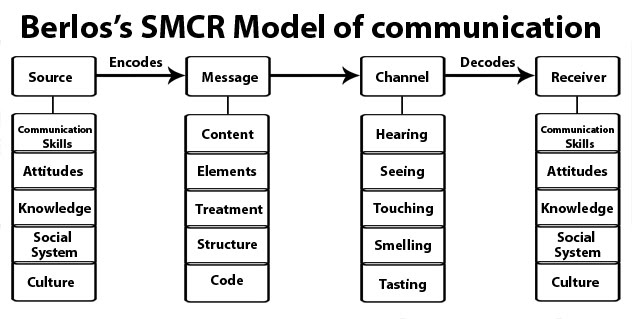
The key strengths of Berlo’s Model of Communication includes:
- The “source” is a vital element that makes the communication flexible enough, and it covers oral, written or any other non-verbal kind of symbolic message (Mortensen 1972).
- Berlo has made the “message” as a crucial element that stresses upon the communication of ideas.
- This model has made “receivers” an imperative factor during a communication process, as they are the basic targets.
- According to David Mortensen, another advantage of Berlos’s model is, “The notions of “encoding” and “decoding” emphasizes the problems every individual has (psycho-linguistically) in translating their own thoughts into words or other symbols and in deciphering the words or symbols of others into terms they themselves can understand” (Mortensen 1972).
There are some weaknesses identified in the Berlo’s Communication Model that includes:
- This model tends to stress upon the exploitation of the message, particularly the encoding decoding procedures.
- The Berlo’s theory does not differentiate between human communication and machine communication, as it is dependent upon signals that are also a means of communication in telephones, radar systems and television.
- The model even highlights that human communication issues can be solved by technical precision i.e. by selecting the “accurate” symbols, eliminating hindrance and sending effective messages (Mortensen 1972).
By critically analyzing the Berlo’s Communication Model, it has been evaluated that this model has provided great importance to the “receiver” that acts as a predominant attractive element during communication processes within the organizations. To better adjust the context, the organizations can rearrange the five basic elements of the sender and receiver for instance by combining social system and attitude and dropping out knowledge and culture, depending upon the working system of the organization.
Wilbur Schramm’s Communication Model
Wilbur Schramm in 1954 introduced a communication model in which he stated that in every communication process both the receiver and sender takes turn one by one playing a role of either an encoder or a decoder. He emphasized upon six main elements, which are source, encoder, message, channel, decoder and receiver (Narula 2006).
Wilbur Schramm suggested that the message might intend to give different meanings displayed by different people. Meanings of the words were categorized as denotative or connotative. Denotative meanings are referred to the words that have mostly the same meaning for every person. On the other hand, connotative meanings are specified as emotional or evaluative and they are based upon personal perceptions. The basic six elements have been illustrated in the following figure. Schramm believed that all six components of communication were necessary in organizational cultures and societies. He explained that every organization needs a proper method of communication in order to prosper and make accurate decisions (Deviny 2010).

From critical prospective, Schramm’s communication model has a number of strengths such as; it provides field of experience and refers to the element of attitudes that the communicators maintain during a conversation. Moreover, it emphasizes upon providing feedback to the sender, as described by David Mortensen (1972) that communication is reciprocal method and feedback is one of the necessary element during a communication process. This model also includes the “context”, as every message has diverse meanings relying upon the certain context. On the other hand, a message might have diverse meanings depending upon the specific culture; therefore Schramm has also made “culture” a vital element during the communication process particularly within the organizations.
On the other hand, one of the biggest weaknesses of the Schramm’s Model is although less linear but it still stresses upon only bilateral interaction between two parties. It cannot handle the complex communication processes that mostly exist in multi-national organizations. Thus this model can be a limitation for conglomerates.
Gerbner’s Model of Communication
In 1956, George Gerbner a professor and theorist of communication studies represented a new model of communication. It was comparatively more complex than Berlo or Weaver’s model, but was based upon linear process. There are two main advantages of this model; first it conveys the message to the certainty while explaining the main purpose of it and eventually facilitates the reader to analyze the questions based upon perceptions and meanings. Second it shows that the communication process consists of two alternating facets, the perceptual or responsive and other facet is the means or control of communication (Fiske 1990). In the figure below the main elements of Gerbner’s model of communication has been explained:
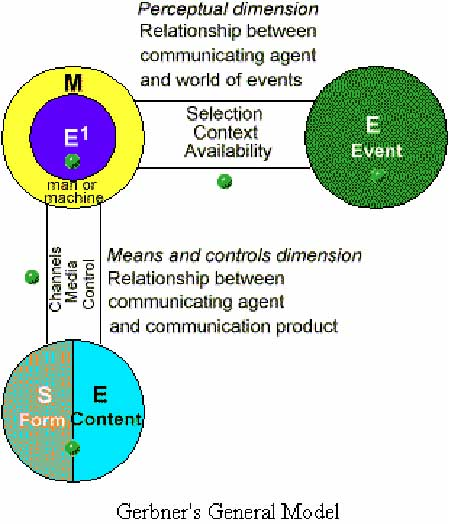
According to researcher’s analysis, the Gerbner’s Model assist to demonstrate the meaning of the message in different shapes depending upon the existing situation within the work context. It makes the communication flexible. It also facilitates the individuals to stress upon their perceptions and beliefs.
Conceptual Framework
Based on the extension of the model the following conceptual framework can be advised for analysing the findings of the present study.
Effects of Verbal Communication within Organizations and Projects
A good verbal communication progress the organization towards the success. Verbal Communications are of two types including oral and written communication. In both of them information is either conveyed directly or with the help of telephone, cellular phones, company’s official website or face-to-face. The most common examples of verbal communication are, interviews, meetings, conferences and seminars. The biggest advantage of verbal communication is that it is quick and free of doubts and misunderstandings. In addition, it also includes a feeling of personal touch (Mukherjee 2009).
Almost every organization agrees that oral communication is the best way to interchange information. It is also highly effective in fulfilling the projects. It has a number of advantages such as it is fast, economical and adaptable. Oral communication doesn’t carry any type of retrieved record of the message conveyed to the receiver, although oral communication is the most effective than any other type of communication. It also enables more flexibility, and saves time and money of employees and management (Champoux 2011).
The management employs oral communication either face to face or through telephone. It built a direct control between the managers and sub-ordinates. The direct contact in return creates a sense of increased importance in them and it works as a form of motivation. Oral communication also gives a feeling of personal touch. It assists the personnel to understand each other feelings by sharing words, which builds mutual confidence between them. Moreover, oral communication consumes minimum time and allows the employees and supervisors to employ the saved time in some other critical task (Kushal 2010). The above factors signify that oral communication has a positive impact upon employees’ performance and has its own substantial worth in the corporate business world.
Another form of verbal communication is written communication. Written Communication is a mode of hand written letter or printed memo, electronic mail, message and report sent via computer network (Champoux 2011).
The written mode of communication fortifies the goodwill and improves the corporate performance, project management and organizational brand image. Written communication facilitates the business to make a positive impression upon the clients and stakeholders by keeping the written records of every department. The main characteristics of written communication are that it provides clarity, accuracy and persuasiveness to the managers and sub-ordinates (Punamarpi 2011).
An organization relies on written communication for several grounds. First of all, the companies can keep permanent records, which is a great obligation in these days due to the increase legal actions of government regulations and requirements. The policies and procedures are also in a written format that enables the individuals to understand and implement them more thoroughly. Writing out a plan instead of conveying it orally facilitates the supervisors to generate a well-structured, well-deliberated message.
Another advantage of written documents is that they are more convenient. It is comprehensive and explained properly as compared to oral communication. It can be read and composed whenever the reader has sufficient time (Guffey 2008). It is retrievable and can be kept as a record for further use. It is re-readable, and can help the subordinates to comprehend the meaning of the message given by their supervisors. Therefore, written communication highly effects the operations of the organization, and helps to keep records and accounts secured for future assistance (Champoux 2011).
Effects of Non-Verbal Communication within Organizations and Projects
Non-verbal communication is another effective communication tool within the business culture, which is often ignored and or underestimated in its affect upon the performance of the organization. The communication experts often mention that non-verbal communication holds approximately 93% of the person’s believability. Out of this 93% almost 53% is visual where as 38% of it is vocal (but it should not be perplexed with verbal). One of the old saying, “Action speaks louder than words” (Perkin 2008) is a very true statement, and this saying also applies on the affect of non-verbal communication within the organizational culture (Perkin 2008).
If these non-verbal communication elements are overlooked then it most probably creates a significant amount of misapprehension and miscommunication between the organizational cultures. The most fundamental types of non-verbal communication are: body movement or kinesics, silence, facial expressions, paralanguage, silence, object or environment, proxemics and people’s view of time (Fielding 2006).
The basic elements of non-verbal communication highly influence the issues of conciliation, contradiction, boss/worker relationships, conflicts, promotions, decision-making and all other areas of project management and corporate development. Therefore the culturally vault non-verbal communication of every sub-ordinate is added to the blend of all interactions within the organization. The intended meaning of non-verbal communication should be analyzed from the whole context but not only from the behavior or attitude of it.
Non-verbal symbols should be understood in clusters, but not individually because sometimes a simple gesture doesn’t always set up a barrier. The misunderstandings of non-verbal communication sometimes influence the co-worker relationships and perspective (Perkin 2008).
Body language is one of the prioritized forms of non-verbal communication. Generally when the individuals engage in face-to-face communication, they express their meanings mostly through their gestures and postures. The facial expressions, movement of eyes and eyebrows, body tones, hand positions and silence all express meanings. It basically adds up or transforms the verbal words. “Body Language” or “Silence” is highly essential especially during job interviews; it enables feedback to the interviewee and interviewer and shows whether the individual is being alleged and understood and also whether his conversation is going to attain its aim or not.
Non-verbal communication is also highly significant if it is encumbered with emotions and value decisions. An observant manager who is able to understand the body language and body tones would analyze the communication more precisely than the other person who is directed only by verbal communication. On the other hand, the manager should also be aware that his gestures and postures are well defined and it may not convey a different meaning than what he anticipates. In order to achieve utmost communication effects, the words should always be maintained with body language and other important non-verbal arenas (Agarwal 2008).
Paralanguage is another non-verbal communication facet that requires great emphasis during project management and corporate performance. Paralanguage covers the ways or tones in which a person speaks, rather than what a person say. It covers variables such as accent, tone, language, emphasis and many more. These tend to be cultural or ethnic indicators classifying the background of the individual.
Paralanguage highly affects the corporate culture, as people with diverse ethnicity are working in a single organization. Therefore many organizations are emphasizing upon identifying paralanguage concepts, and have surpassed the fundamental areas of distinctiveness to cover measurements such as; social class, educational level, aptitude and viability (Perkin 2008). These are non-verbal communication arenas help to drive higher economy and global relationship between and within the organizations.
Impact of E-mail Communication
In today’s era, incorporation of Information and Communication Technologies (ICTs) predominantly the Internet happens to be the most imperative tool in both well-recognized and rapidly developed organizations. The use of Internet has become highly essential for global communication and the utilization of personal computers and Internet service is increasing rapidly. It has become a fundamental of everyday subsistence at workplace, home and other public places. The Internet has brought an opportunity for the users and companies to diversify their businesses internationally. A significant number of people are using Internet and today it has turned out to be an entrenched part of everyone’s lives (Hussain 2009).
The Internet is the most prevalent international network that be applied in several ways and for diverse objectives. Internet is an effectual element of communication that enables enormous opportunities for people to interact proficiently and competently with their peers, subordinates and instructors. It also facilitates a conductive environment for managers and executives to share ideas and information, and communicate to each other to effectively accomplish their tasks and goals (Hussain 2009).
Computer-Mediated Communication (CMC) has become evident in the working environment of every organization. Most specifically E-mail has been the predominant type of CMC at the workplace. In addition, the growing use of cellular phones in business has opened a new dimension of e-mail usage. E-mail is not only considered as a tool to make communications over long distance, but emails also assist in making and closing the business deals.
Today, colleagues and sub-ordinates can interact and communicate with each other via emails. E-mail provides a number of advantages such as; it is less time consuming, it is more effectual than telephonic communication, it is more reliable and comprehensive. Studies show that e-mail promotes the personnel to communicate more effectively and is crucial for accomplishment in organizations (Derks and Bakker 2010).
Email is ranked as an attractive source of communication because it is expected that people can contact each other effortlessly and quickly. People can easily manage time and concentration while reading and answering the emails. In addition, most of the people are in a habit of reading and replying to the message instantly, and that is the main reason email has became one of the highly successful medium of communication, and no doubt the reply is mostly as fast as one receives a phone call (Derks and Bakker 2010).
E-mail has also enabled a facility of providing feedback messages to the sub-ordinates. Since messages via email have verified to be highly practical in the interchange of documents, thus email has become highly beneficial to provide feedbacks on those documents through the use of email. Today, organizations take feedback as one of the pioneer step towards personal development and progress. Therefore, the use of e-mail has become highly popular and useful within all organizations, and it has a great impact upon the corporate performance (Derks and Bakker 2010).
Communication Barriers and How to overcome these Barriers
Several communication barriers arise when the co-workers are interacting with each other within the organization. Some of the common communication barriers are cultural barriers, language barriers, individual barriers and other personal barriers.
Cultural Barriers
Cultural difference often compares the beliefs and values of different cultures and usually misjudged according to the principles of right and wrong of one’s own culture, such approach is also know cultural relativism (Krizan and Merrier 2008). This dissimilarity often turns out to be a barrier when one assumes that cultural values, attitudes and norms are incorrect if they differ from one’s own culture. Many individuals working within an organization ethnocentric, they believe that their own cultural beliefs are superior to other person’s beliefs. Some of the individuals are gender-biased as well. In some cultures social hierarchy or roles and status matters a lot.
For example, in most of the organizations White men believes that they are superior to other men of any other ethnicity (Berger 2008), which creates a communication barrier between them. Sometimes the women feel reluctant in making conversation with men especially at the workplace. In contrast men from same cultural backgrounds don’t feel comfortable working with women especially having women as their supervisors (Krizan and Merrier 2008).
Cultural barriers can be overcome by understanding each other’s culture and backgrounds and appreciating each other’s values, beliefs, and behaviours. Learn the concepts and customs of other cultures without judging and comparing them from one’s own culture, which would basically help the individuals to understand the interpretation of verbal and non-verbal language of different cultures. Avoid stereotype people and men should give value to women at workplace and similarly females should have mutual respect for men.
Individual Barrier
Another barrier, which can arise, is an individual barrier. Apart from the society there are also some individualistic approaches. This obstacle is based on individual’s perceptions and personal discomfort. For example, there are some employees who are reluctant or unwilling to speak to their superiors what so ever their position is in the hierarchy. The reason for this could be the fright of being sacked or patronized.
Due to the result of unfriendly management, or unapproachable culture adopted within the organization the capabilities of an employee is restricted. Developing an easy going and relaxed culture within the organization, which will help employees to explore their self, can minimize these psychological barriers. For example, the culture that is adopted in Google Company allows every employee to have a right to discover his or her creativity (Hhan 2010).
Physical Barrier
The third barrier is the organizational barrier, or it is also known as the physical barrier. This includes inadequate facilities provided, outdated equipments, strict rules, distracting environment, over depending on technology and an overall flawed structure in the frames of multinationals. An example could be too much dependency on the new technology might create problems, for example if only emails are sent or message is only uploaded on the websites, without the access of Internet the message delivery is useless. So, to avoid these circumstances management should always have a backup, or message should be delivered according to comfort of the receiver (Hhan 2010).
Channel Barrier
An inadequate communication structure in an organization can create many hurdles; this kind of barrier is known as the channel barrier, which depends on the length of the communication of the medium selected. For example, strongly centralized organization may reduce the capacity of communication in a MNC. Also a tall structure can lead to too many vertical communications, so in result message becomes distorted after passing through so many levels. In order to overcome this barrier the management should allow upward, downward, vertical and horizontal communication.
The organization should try to control the chain of command and also encourage two-ward communication. Coming towards the selection of the medium; is it very important to choose the right medium of communication so that the message is correctly conveyed or understood by the receiver. Examples of medium are telecommunication, face to face, written media and the electronic media. To eradicate media barrier, an appropriate and rich media should be used according to the situation. There should not be any fixed media set and variations should occur in the selection of media according to the circumstances. For a manager to humanize its presence all over the organization is very important, and it can only be done through correct media selection (Hhan 2010).
Interpersonal Barrier
The interpersonal barriers from the employers are; lack of trust in employees, shortage of times for employees, lack of coordination, lack of non-verbal communication skills such as body language, less consideration of employee requirements and lack of motivation. In order to reduce such problems the employer should have a clear understanding about the human resource management. Although it is difficult to create trust among employees but by sharing the key information, discussing issues and communicating honestly with employees and employer can build a sense of trust and affection.
Managers often forget about the non-verbal communication. Correct body language, proper posture and formal dressing signifies the serious attitude towards work. If an employer body language is informal, the message he or she is delivering might not be that influencing to the employee, which leads to interpersonal barriers (Hhan 2010).
Language Barrier
Accelerated globalization allows the MNC to interact with many different nations, and in order to communicate with them the key barrier, which arises, is the language barrier. Language barriers can have affect on the trainings held in different countries and also on cross-culture teams (Luo and Shenkar 2006). The diverse geographical regions encounter language barriers when communicating within the organization.
Language also influences the conflict management in cross-cultural groups. It is by means of language that management of multinational organizations builds their strategies and procedures, distribute and execute them. A language design should be established that would be used as a strategic instrument with which multinational companies will align their operations and strategies throughout the multiple atmosphere of the organization in which it functions.
According to one research, “This language plan entails the expansion of a language system in which parent functional language and subunit functional languages are concurrently used and recursively related through the multinationals communication network. Proper language design can improve intra-network communication, inter-unit learning, parent-subsidiary coordination and integration, and intra-unit value creation within a geographically dispersed network.
To achieve these gains, however, the companies need to build a globally integrated language system so that its parent functional language aligns properly with its strategy, structure, and level of internationalization, while each subsidiary’s functional languages configures with its strategic role, organizational positioning, and expatriate deployment” (Luo and Shenkar 2006).
Hypothesis Setting
- H1: Both verbal communication and non-verbal communication have positive impact upon corporate performance
Studies have shown that both verbal and non-verbal communication processes and techniques have highly influenced the working environment of the organization. The most successful firms have underscored one basic element and that is the communication should be open at all levels. Even a high-tech firm believes the technical business can be successful not by mechanical processes but by the people within the organization, ideas and communication.
Communication helps built a sense of responsibility. It should be promoted at all levels within the organization. The co-workers and staff should feel comfortable to share their ideas with anyone within the corporate culture even with the CEO. This would help create an encouraging working environment and would facilitate innovation and higher results. Furthermore, a successful organization always provides great importance upon creating human relationships and associations by applying communication processes (Bonitz 2007).
- H2: The positive perceptions regarding communication within organizations has positive impact on employees’ performance
Employees play a crucial role in organizational accomplishment. As described in Stanley’s theory communication highly influences the employee’s performance. The basic purpose of building communication relationships in every organization is essential to involve and give value to people in the organizations. Communication brings a sense of accountability in the employees and they perform best when they are allowed to make suggestions on issues that distress them.
Effective communication is pivotal to the management process and is crucial in bringing organizational change. Communication helps build effective manager-employee relationship; it improves decision-making process by facilitating the co-workers to express their ideas and eventually help the senior management to derive precise decisions (Hayward 2005).
The communication process is highly accepted by the employees, as it improves their performance and they are more committed to their work when they are provided with accurate information about their tasks such as updated instructions, accurate deadlines, feedbacks and job satisfaction. In addition, communication help generate a sense of motivation in the employees, as they encouraged to articulate their views, ideas and suggestions (Hayward 2005).
Communication is also a vital tool for eliminating legal conflicts within the workplace. Communication is considered as a strong catalyst for forming and maintaining the emotional state shared by committed employees and leaders. Organizations that are having best relationships with their employees are the ones that are attaining higher revenues and moving towards prosperity.
Summary
The literature review presented in this section of the paper provides the basis for the conceptual framework for the analysis of the findings of the present study. This chapter discusses different theories and factors determining the effect of communication in the organizations and projects and consequently, the advantages accomplished due to the communication process. The theories discussed in this section provide a deeper understanding of the communication process.
Most of studies mentioned in the literature are from the European countries as the current study takes place within Lebanon. A number of factors have been identified that motivate the managers and their sub-ordinates to have appropriate communication skills within their working environment. Two hypotheses have been proposed to be tested in order to evaluate different factors determining communication skills with respect to the performance of the employees.
Research Methodology
Introduction
Research methodology is a manner adopted to solve problems. It is more highlighted as an art of figuring out ways to conduct research scientifically. However, it is necessary that the researcher is aware of the techniques. Every problem needs to be solved through a different technique and methodology; this requires the researcher to have proper knowledge about the dimensions and research methods (Kumar 2008).
The purpose of research is to find out the unveiled truth or make a new discovery through theoretical and hypothesis support. Even though every study conducted has its own function. The approach used in the current research for analysis of primary and secondary data to disembark at reasonable conclusions is explicated with its reasoning and precincts. The data collection techniques utilised for primary and secondary research are also analysed in this chapter.
Qualitative vs. Quantitative Research
Quantitative research is conducted when a conclusion from the data collected in research has to be in numerical format. Since it’s in numerical format, that data is very well structured and all the variables are measured in terms of magnitude. Quantitative research basically revolves around performing statistical analysis such as counting and measuring of data to create an outcome with is reliable, reasonable and underlines the theme of cause of effect.
Quantitative approach comes with many benefits as compared to other approaches. The most highlighted ones being they represent problems in a very definite manner clearing showing both the dependent and the independent variables used in research. The research revolves around reliable data, which is gathered through observations, mass surveys, lab experiments and many other resources. As a result, the research is extremely goal oriented and gives out objective based conclusions (Matveev 2002).
Qualitative research mainly focuses on creating theoretical researches, which are based on experiences witnessed by people involved in research. Qualitative research usually occurs in natural settings where the subject matter is visualized during its normal routine activities. The researcher works in a framework that focuses on investigating any issue till he is able to drive a conclusion as to why particular behaviour is depicted.
For the purpose of the present study, quantitative methodology is chosen and implemented. The reason for this is that the present study could be considered as an extension of the existing literature and performance of co-workers and business environment established in previous studies to evaluate the communication trends in some of the Lebanon organizations.
Even though, quantitative approach has been chosen for the present study however, it is comprehended that the results acquired from a research using quantitative approach will only be relevant for a particular research and would be intricate to employ in generalised conditions. Some of the specific variables are considered where as some of them are overlooked (Tull and Hawkins 1993). This could be measured as a constraint of the adopted research methodology in this study.
Inductive vs. Deductive Research
Where the subject of the research is too diversified in nature then inductive method is brought into use. After the identification of the problem, research audience is targeted and observed through several means. On the basis of observation and analysis patterns of behaviour are pointed out and conclusion is derived (Kothari 2008). Many of the researches begin with inductive method. Identification of the problem is a rather difficult step in inductive research process. The identification leads to series of detailed studies known as programmatic research. The hypothesis created out of inductive research is just theory based and are not supported in numerical terminology (Singh 2007).
When reasoning is dragged from being totally general to more specific results deductive methods are applied. Also known as a top down approach, under this approach the analysis is narrowed down into a much more specific and concise hypothesis. The hypothesis gives out more valid reasons than just biased reasons as to why a particular problem was chosen to be solved. The hypotheses derived are further studied through series of experiments (Saunders, et al. 2007).
For the present study, inductive approach to the study is adopted, which is most suited for quantitative research. Keeping in view, the nature of the study it is useful as the scope of sample selected is limited and the results, which are obtained from the survey, can be easily generalized for the Lebanon population.
Data Collection
Data for the present study is gathered from various sources namely primary and secondary sources, which are discussed in this section of the report.
Primary Data
Primary data is the data that is gathered for the very first time through research questions. The questions are very precise making the researched answer according to the point. The major benefit of primary data is that the information is holds value and is up to date (Saunders, et al. 2007). For the present study, a survey questionnaire has been conducted.
The questionnaire that has been designed and implemented for this study is based on an extensive examination of previously published studies related to different communication aspects, which actually motivate employees and business environment to prosper It is clear from the conceptual framework presented in Chapter 2 that the present study covers two basic aspects of communication observed amongst employees and corporate structure.
The questionnaire majorly comprises of closed ended questions. It is structured in such a way that different elements of research which would assist in testing out the research hypotheses are addressed under different section headings, and in order to cover each aspect in detail and keep an objective approach to the findings of the study these areas are included in the questionnaire by providing various statements for respondents to respond.
The nine parts of the questionnaire include statements along with corresponding ranking scale for respondents to select their responses. This approach is based on Likert Scale Model which allows respondents to simply select from a choice of possible answers based on the ranking from 1 to 5 where
- “Strongly Disagree”;
- “Somewhat Disagree”;
- “Neither Agree or Disagree”;
- “Somewhat Agree”
- “Strongly Agree”.
Detailed discussion of each part of the questionnaire is hereby, followed along with the area of investigation that they are aimed at two main hypotheses, which are discussed in detail in the following:
Positive impact of verbal and non-verbal communication on corporate performance
The questionnaire initiates with a set of statements that are aimed at evaluating different aspects of communication levels as to how they improve the performance at corporate level and what positive factors it brings within an organization. This is included as a part of the study and based upon different studies, which suggest that both verbal and non-verbal communication creates a sense of responsibility among the employees and the senior members. Both verbal and non-verbal communication provides great emphasis during project management and corporate performance. Responses collected for this part are used for testing out the first hypothesis set out in the previous chapter.
Positive perceptions about communication improves employee’s performance
Part 6 and Part 7 of the questionnaires highlights the positive perceptions about communication that influences the performance of employees. It clarifies how communication helps to bring a sense of accountability in the employees and how it builds effective manager-employee relationship. The questions also highlight the importance of employee feedback, as it motivates the employees and encourage them to share their ideas. Responses collected for this part are used for testing out the second hypothesis set out in the previous chapter.
Secondary Data
The current report makes extensive use of secondary information, which is available from different sources. Data gathered from other researchers is secondary data. The purpose of using secondary data is to cut the research cost and use the data, which is already available. If the data is in quantitative form then it will be in statistical terms if not then it can be collected from journals, documents and any other form of unstructured data. The best aspect of secondary data is that it lets the researcher to start with the research without setting the base from scratch. The biggest benefit acquired from secondary sources is that it attracts the researchers to utilize these required to save time and cost.
Sampling
Since, the present study is targeted at employees working in organizations located in Lebanon therefore, it is important to gather views and responses of individuals who are living in the country. Moreover, due to the type of research methodology adopted it is useful if a larger sample size is selected in order to perform the standard deviation and bringing out the results necessary for validation of the research hypotheses set out for this study.
The selection of respondents is made through a list of email addresses that the researcher had obtained of local residents in Lebanon and written requests were made to them for taking part in the survey. The selection of respondents was random. Since, the expected response was low therefore, email was sent to 50 individuals. The pilot study was carried between ten individuals working in different organizations then after checking the results the main survey was conducted among 50 employed individuals. Selection of 50 respondents was made basically due to restrictions of time and also to give sufficient representation to employees working in different companies.
Basis for Analysis
For consistency of data collected, Cronbach’s Alpha has been calculated which suggests the consistency of responses provided by individuals to the statements inquired. The basis for analysis set out for the present study is established in order to evaluate the affect of verbal and non-verbal communication upon corporate performance and the positive perceptions of employees related to communication process. Descriptive analysis is made to present findings from the primary research in the form of percentages of responses collected.
The responses would help to verify the degree of relationship between the variables. Based on the model depicted in Chapter 2 for predicting different relationships leading up to effective business performance, the correlation matrix is carried out for testing out the research hypotheses. Since, different elements of investigation are addressed in the questionnaire by including number of statements therefore, mean values are used for responses made by individuals.
Demographic factors such as gender, age, educational level, and ethnicity are analysed for their impact on the communication trends in order to form opinions regarding hypotheses H1 and H2. The findings from the study are then discussed in light of the conceptual framework set out for this study and identify the differences between the present study and findings from previous similar studies for serving the literature gap that has been identified in Chapter One of the report.
Statistical Software
The data collected from the survey questionnaire is subjected to descriptive analysis and a small statistical test using SPSS17® which is a powerful tool for performing statistical analysis specified for this study.
Ethical consideration
There are certain ethical considerations that need to be discussed here for assuring that the present study meets ethics requirements of the university. The study has been undertaken after giving due consideration to the ethical guidelines provided by the university and all efforts have been made to ensure that issues of plagiarism and giving due copyright credit to original writers or publishers of secondary information. Moreover, the primary research has been carried out only upon seeking approval from the concerned authority.
As an ethical consideration employees of various organizations that are targeted via survey questionnaire have been requested for their consent and are informed of the purpose of the study and also their rights to withdraw from the survey at any time. Furthermore, it is hereby, stated that the research questions and the information provided in this report are not exhaustive in a way that business decisions can be made on the basis of conclusions provided in this report. Distribution and publishing of this report is also restricted and can only be made upon the permission of the researcher or his instructor.
Research Methodology Limitations
The selected research methodology is considered most appropriate for the purpose of achieving the research objective however it surely has certain limitations that could affect the outcome of the study carried out in this report:
- The survey questionnaire was carried out in the organizations of Lebanon that could be considered to have impact on the scope of the research as employees and managers working in particular organizations tend to share similar behaviour and values, and diversification in responses may not be achieved.
- The element of biasness and certain level of subjectivity exist in the responses collected, as all of the respondents are working on the similar occupations in different companies and they may share similar views and opinions.
- The quantitative approach selected for the research is considered to be descriptive that is very much dependent on the ability of the researcher to gather vital information and analyze to present a comprehensive analysis of various organizations. The researcher’ own knowledge and understanding of different analysis tools and information collected for the study can also be considered as a major limitation to the study. However, there are other factors that could have incorporated such as ethnic grouping of sample, interviews with the senior executives etc.
- Although the researcher has made all possible efforts to avoid cases of plagiarism and copyright in the report however it is rather impossible to avoid it as the analysis is based on important facts that are collected from different available sources. The customer does not verify the authenticity and reliability of the information gathered from these sources. Therefore, their use is somewhat subject to the inherent risks of usage.
- Moreover, previous studies that have been highlighted in the literature review are carried out in independent framework separate from the present study and the inherent limitations of these studies could be considered as part of the limitations of the present research.
- Time and cost factors could be considered as delimiting variables that have affected the ability of the researcher to collect data and analyze it using different strategy analysis tools.
Findings and Analysis
Introduction
This chapter provides an inside to the results that are derived from statistics, to understand the link between the communication and the performance of employees and corporate that has been selected for the present study. This chapter also define the role of demographics effecting the communication within organizations. By the end of this chapter, a comparison between the present study and the literature review will be discussed with the help of analysing the findings of this study, in order to understand the effect of communication and its dynamics.
Reliability Analysis
Cronbach’s Alpha is applied to the study in order to determine the consistency in the responses collected from the respondents. The results included in SPSS are shown below. It can be observed from the above table that the Cronbach’s Alpha value of consistency in responses is 0.894 against the standard value of 0.7, which suggests high level of consistency in responses collected.
Descriptive Findings
Total 50 respondents were asked to complete the primary survey that was conducted in an uncontrolled environment and these 50 completed questionnaires were accepted suggesting that the outcome taken has a greater consistency and completeness of responses gathered in primary survey. This consistency level helps in achieving the goals of this study through statistical analysis of data.
Demographic Factors
Age
Most of the respondents were of young age that is 26-30 years. Second majority respondents were of middle-aged people belonging to age bracket of 35 to 37. Other respondents belonged to age bracket of 25, 31 or 33. This states that every person within his or her firm is highly interested in effective communication.
Table 1: Age.

Gender
Out of 50 respondents, majority were male respondents comprising 58.0% of the total responses. Remaining 42.0% respondents were females. Although there is only a slight difference between the percentages, which reflects that both male and female are involved in organizational matters and highly supports communication within their organizations.
Table 2: Gender.
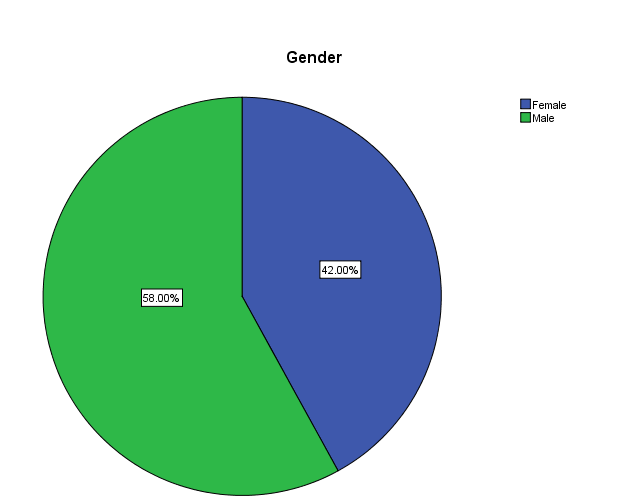
Position
From the responses collected against this question, it is evident that respondents have different positions. Most of them were directors. Second majority respondents were accountants and managers. Rest of the respondents were analysts, administrators, architects, consultants etc. These findings are important as they form the basis of an important statistical test performed in this report.
Table 3: Position.

Ethnicity
The responses collected for this question showed that the majority of the respondents were Arabs, which is reflected in the results as 76.0% of responses were made by these individuals. The survey was held in Lebanon therefore majority of them Arabs and 22% of them belongs to other ethnicity.
Table 4: Ethnicity.

Communication
Communication is highly encouraged within our organization
Results in Table 5 clearly shows that majority of the respondents believed that communication is one of the most imperative aspect of an organization. None of the respondent disagrees with this fact. This verifies that communication is the most basic norm, which should be open at all levels within an organization and projects. 40% of respondents stated that they strongly agree, just like Stanley Deetz theory, communication is a central procedure through which the sub-ordinates and managers share information, build relationships, express ideas, give suggestions and construct organizational philosophy and principles. On the other hand only 6% of the individuals were neutral, which means that only 3 respondents did not show any concern regarding the communication level.
Table 5: Communication encouraged within organizations.
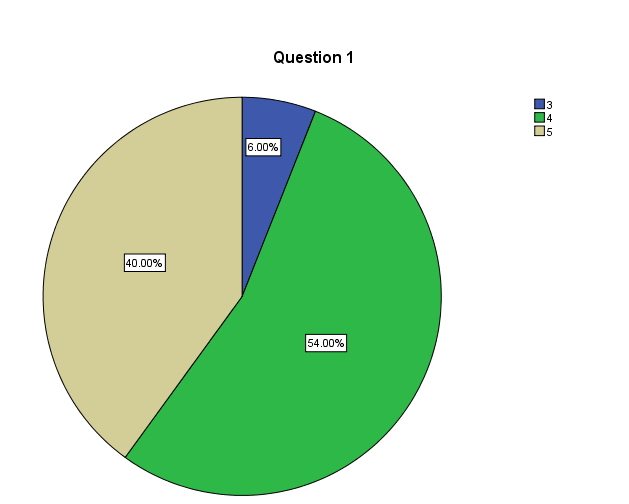
Ideas and Information are shared openly within our organization
Information and ideas that are transmitted between the sender and receiver within an organization highly influences the performance of corporation. The results states that 46% of the individuals agree with this fact and their organizations highly encourage the ideas and information to be shared between the managers and sub-ordinates that eventually brings a positive factor within the company’s environment. Although 22% of the respondents said that their organization are more hierarchical and it does not support sharing ideas openly among their co-workers. This clearly shows most of the males agree with the fact, but the females still feel that the effect of communication level is still missing in some of the organizations.
Table 6: Information shared within organization.
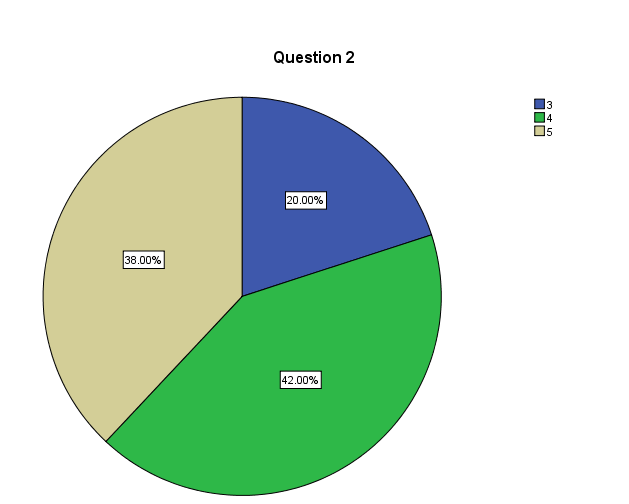
Supervisor encourages the employees to give ideas and share information
Large portion of respondents, 50% of them responded that their supervisors and senior executive members are highly supportive and they encourage everyone within the organization to share ideas and provide their suggestions. 38% of them highly agreed and believed that sharing information helps the company to prosper and perform well. Just like mentioned in Berlo’s Communication Model, that messages and ideas shared between the sender and receiver helps to eliminate ambiguity while encouraging effective decision making.
Table 7: Supervisors encourage the employees to share ideas and information.

Supervisor explains the task assignments clearly
Results clearly explain that majority of the respondents firmly agrees with the statement, and they believe that their supervisors are highly corporative and they encourage communication within their team members. The following table clearly verifies that 54% of respondents get full explanation of their tasks from their senior members, which is a positive aspect for the organizations and the employees.
Table 8: Assignments clearly explained by the supervisors.
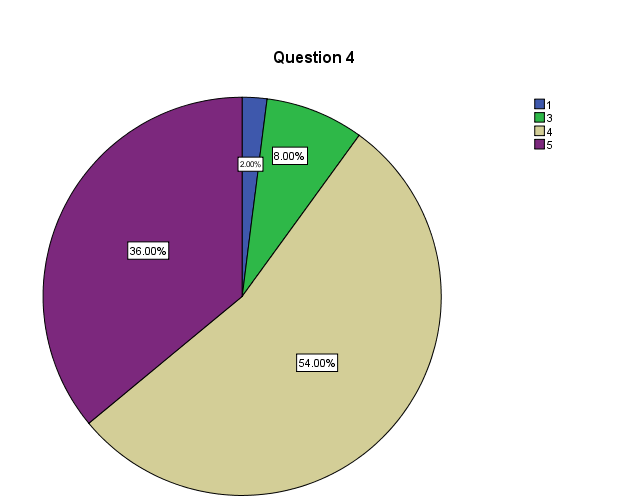
Senior management communicates in a friendly manner with all of the sub-ordinates
50% of the respondents responded that the senior management communicates in a friendly manner with each of the member within the organization. This emphasizes upon the third factor called “Involvement” being discussed by Stanley Deetz in the literature review. He states that involvement includes openness and being friendly with the employees, which allows employees to share their grievances, desires and ideas and permits to suggest improvements.
Table 9: Senior management communicates with subordinates in a friendly manner.
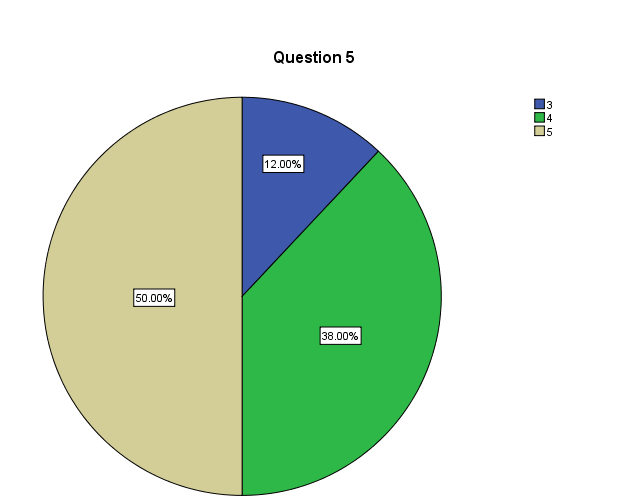
It is easy to communicate and share information with the colleagues and sub-ordinates
In the table below it clearly verifies that majority of the respondents i.e. 42% of them responded that communication is highly acknowledged within their organizations and they are allowed to share information and ideas with their colleagues and sub-ordinates that helps to eradicate misunderstanding and leads towards profit maximization and better decision making.
Table 10: Communication between colleagues and sub-ordinates is easily handled.
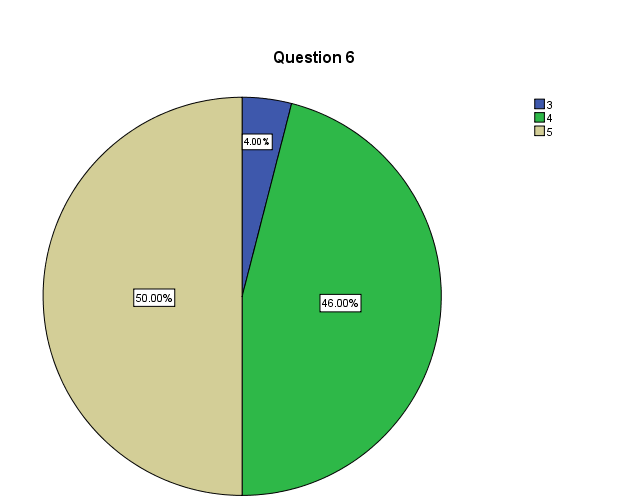
Verbal Communication
Every individual at workplace is informed about latest policies and procedures via written letters
The responses collected from this question showed that 40% of the individuals strongly agree and 48% of them agree with the fact that verbal communication is highly essential for the progress of an organization. The respondents state that their organizations are also following verbal communication facets by informing about latest policies and procedures via written letters at workplace. This signifies that written communication is being implemented, which fortifies the goodwill and improves the corporate performance.
Table 11: Policies and procedures are informed through letters.
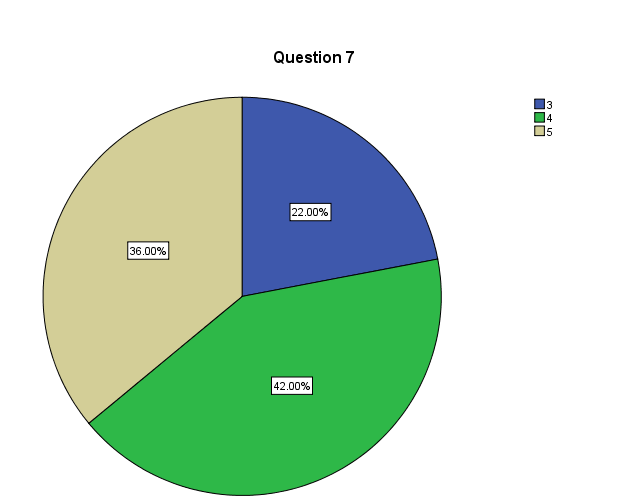
The organization keeps the records in a form yearly reports and written documents
It is clearly stated in the literature review that written communication facilitates the business to make a positive impression upon the clients and stakeholders by keeping the written records of every department. The table given below elaborates that 42% of the respondents say that their organizations are keeping the written records of their firms in the form of yearly reports, which helps to provide transparency, precision and persuasiveness to the managers and the sub-ordinates.
Table 12: Records are kept in the form annual reports and written documents.

Every person within the organization is updated about company’s performance and information by monthly newsletters and bulletin boards
Monthly newsletters and bulletin boards have now become one of the effectual forms of communication within the organization. They are highly helpful and save time of supervisors as well as of employees. Majority of the individuals stated that they are handed with monthly newsletters that give them convenience and it helps them to remain updated of the organizational activities and accomplishments.
Table 13: Newsletters and bulletins used for providing update status of the company.
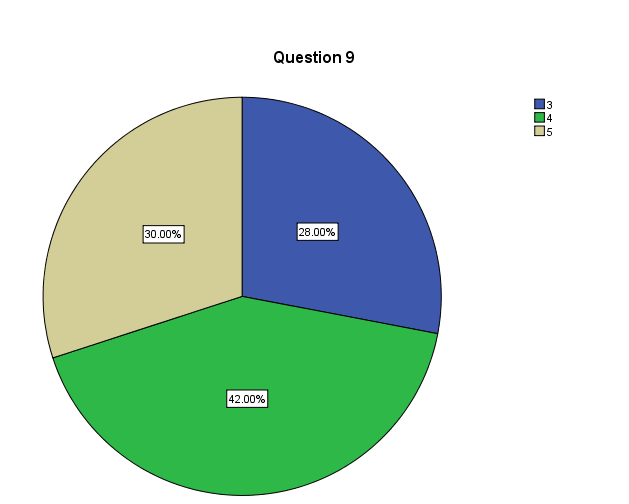
Fax machines and telephones and intercoms are use to be always connected to each other within the organization
Fax machines and telephones is another way of verbal communication. It comes under the category of oral communication, which is also highly essential for the operations of organization and connectivity within the employees. 54% of the respondents stated that telephones and intercom facilities are used within their companies, and it gives them a feeling of personal touch and it builds a direct control between the managers and sub-ordinates. The direct contact in return creates a sense of increased importance in them and it works as a form of motivation.
Table 14: Fax machines and telephones are used for being connected within the firm.

Non-Verbal Communication
Every person is fully aware of non-verbal communication during business encounters
Non-verbal communication is one of the imperative factors for an effective business culture but it is often overlooked, although the following table suggests that non-verbal communication is highly accepted within the business encounters, which is a positive factor. 46% of the respondents strongly agree and with the fact that every individual within his or her company is fully aware of non-verbal communication and also applies it within their business context.
Table 15: Awareness of Non-Verbal Communication.

Handshake is an important non-verbal arena for accepting business encounters
Results in Table 16 clearly show that most of the respondents are willing to accept non-verbal communication factors. They believe that handshake is highly necessary for accepting business encounters. Majority of business people of Lebanon prefer shaking hands for showing approval and appreciation during business deals.
Table 16: Importance of Handshake.
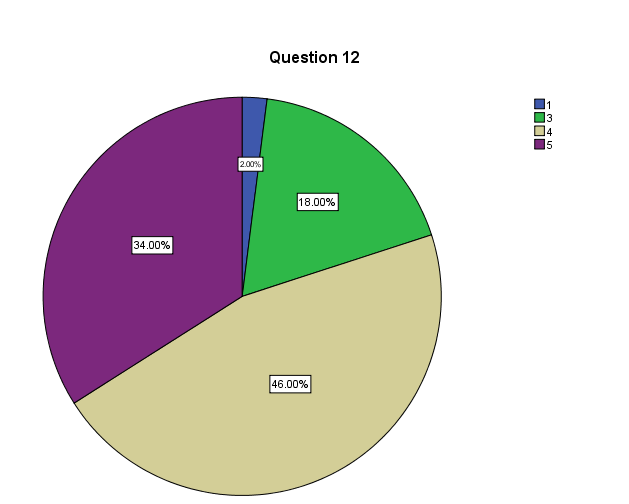
The supervisors and other subordinates give the amount of personal space to every person during conversation
Giving the amount of personal space comes under the category of paralanguage in non-verbal communication. Paralanguages tend to be cultural or ethnic indicators classifying the background of the individual, which highly affects the corporate culture. According to the survey results, it clarifies that in Lebanon some of the organizations and personnel prefer personal space during conversation and some of them does not mind if there is not an enough amount of space, as 20% of the individuals have neutral response that elaborates that amount of personal space differs from person to person.
Table 17: Personal space during conversation.

The senior executives are highly concerned about the personal appearance at the workplace
Majority of the respondents stated that personal appearance is imperative at their workplace. The senior executives are concerned about the dressing and outer look of their sub-ordinates. They prefer their employees to be well dressed and look professional. Good personal appearance makes your employees look distinctive and unique from others.
Table 18: Personal space during conversation.

Eye contact and gestures influence the outcome of business encounters
Eye contact and gestures basically adds up or transforms the verbal words and comes under the category of “Body Language.” Well-defined gestures help to achieve the utmost communication effect. As 48% of the respondents to this question agree that gestures and eye contact should be clear and precise as it greatly influences the outcome of business encounters.
Table 19: Influence of eye contact and gestures.
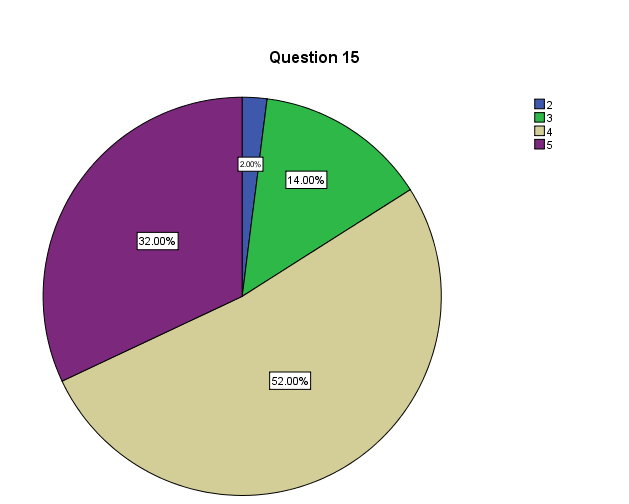
Electronic Communication
Every sub-ordinate has access to email
Email is today a predominant type of Computer Mediated Communication at every organization. From the responses collected against this question, it is evident that majority of the respondents have access to email within their business culture. This proves that email is ranked as an attractive source of communication, as it is less time consuming and it is more efficient than telephonic communication.
Table 20: Email access for every sub-ordinate.

Every individual within the firm receive all the updates and weekly information via emails
Results show that 46% of the individuals strongly agree and 40% agree with this statement that their firm provides all the updates and weekly news bulletins via emails to each member of their organization. Email has become a facility for the company’s personnel and has a great impact upon the corporate performance.
Table 21: Updates and information is received via emails.

The company has its own databank
Many of the respondents are of the view that their organization has its own databank, and it is a necessary tool for keeping company’s data and required information safe and up to date all the time.
Table 22: Own databank.
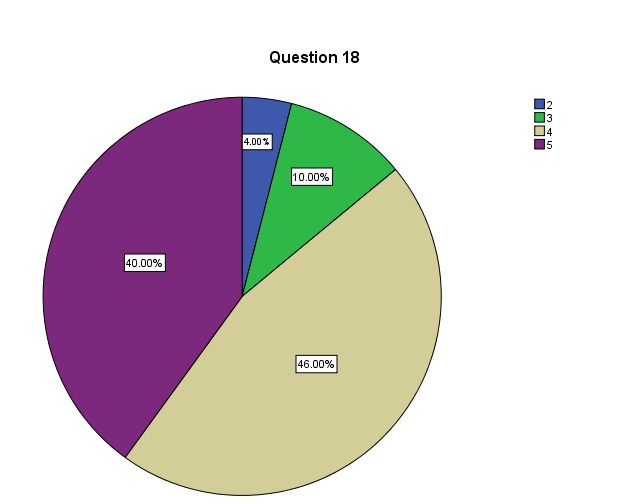
Every person can give suggestions and complaints on the company’s personal feedback page
Electronic mails have enabled an opportunity of providing feedback messages to the subordinates. The results given below also verify that email is highly practical and beneficial for providing personal feedbacks to the employees and managers.
Table 23: Suggestions and complaints are given on company’s feedback page.
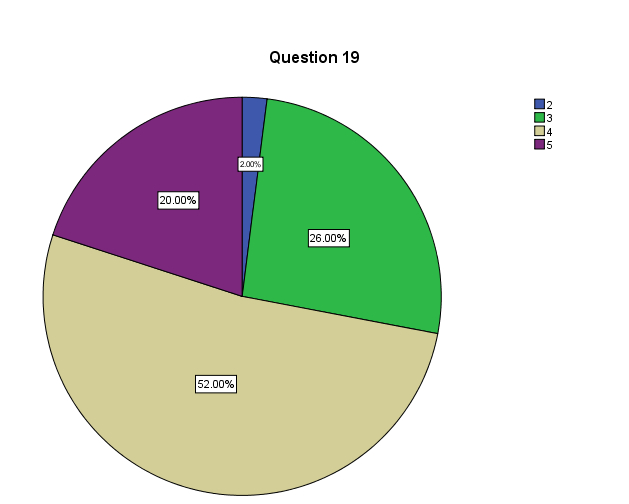
Corporate Performance
Increased communication has positive impact on corporate performance
In every organization communication should be open at all levels. In today’s business era communication has become the most vital tool to progress the corporate performance. 70% of the respondents also believe that communication should be promoted at all levels within an organization, as it facilitates innovation and higher end-results.
Table 24: Company’s performance is highly influenced by communication.

It is believed that the company’s performance has improved due to communication
Majority of the respondents were in the favor of communication. They suggested that their company’s performance has achieved higher success due to open communication. They also said that communication brings a sense of responsibility, and all the subordinates and staff members feel comfortable to share their ideas with anyone within the corporate culture even with their CEO.
Table 25: Company’s performance improved by communication.

The company has sufficient monitoring system for communication
50% of individuals consider that their organization has an excellent monitoring system of communication. The company always tries their best to eradicate channel barriers, and always choose the right medium of communication so that the message is correctly conveyed or understood by the receiver at the workplace.
Table 26: Company’s performance improved by communication.
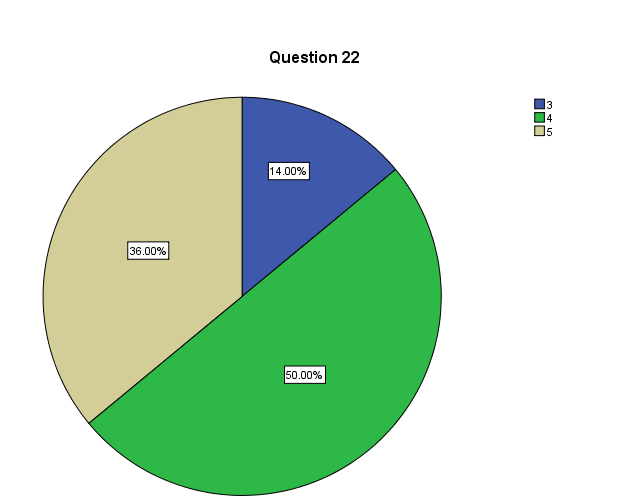
Feedback
Every individual within the company gets valuable and productive feedback from the executives
Majority of the respondents stated that they get constructive and dynamic feedback from their senior executives. Communication process is highly recognized by the employees, as it helps them to acquire accurate information about their tasks such as updated instructions, accurate deadlines, feedbacks and job satisfaction.
Table 27: Sub-ordinates get valuable feedback.
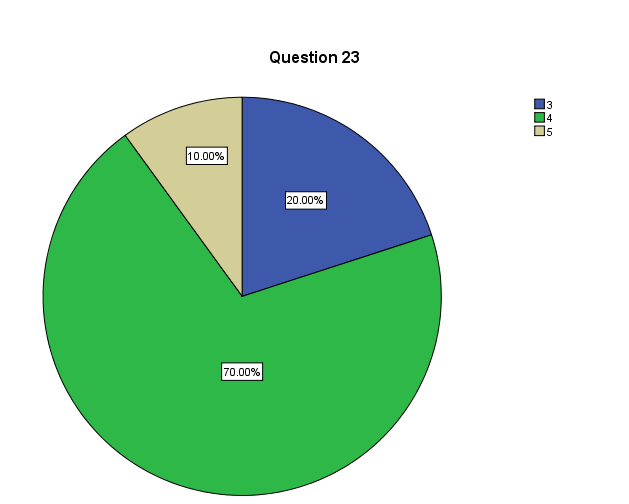
The feedback is in a form of oral and written communication style
Feedback should always be in a form of both oral and written communication. The Figure below also states that 64% of the individuals receive their feedback in both types of verbal communication. This helps them to generate a sense of motivation and encourage them to articulate their views, ideas and suggestions to their managers and senior executives.
Table 28: Feedback is in a form of oral and written communication.
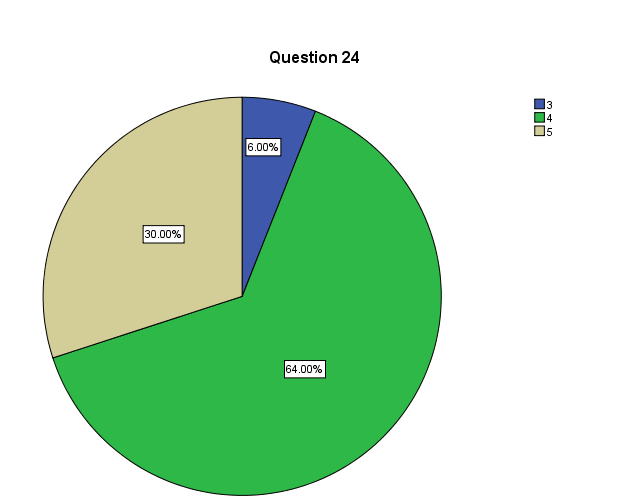
Satisfactory feedback is received about employee’s performance
A large number of respondents responded that they receive a positive feedback about their performance, and it helps them to perform even better. Although 40% of the individuals are not satisfied with their performance feedbacks, which clearly explains that their organizations should enable satisfactory feedback to their employees, in order to save time and maintain employee retention.
Table 29: Employees receive satisfactory feedback.
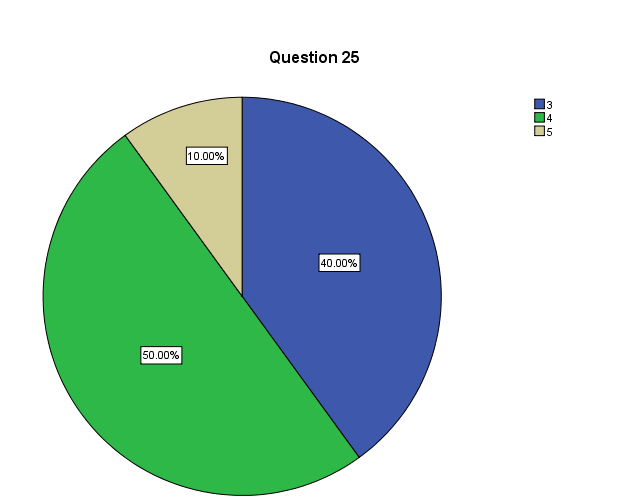
Everyone at the workplace always praised and acknowledged by the manager and senior executives when they do a good job
Organizations must have best relationships with their employees and the managers and senior executives should always acknowledge their staff members for performing well as it helps to raise the motivation level of an individual. The results regarding this questions state that 50% of the respondents have friendly managers and they always receive appreciation from their supervisors for doing a great job, so eventually they feel confident and perform even better.
Table 30: Senior staff for performing well praises employees.
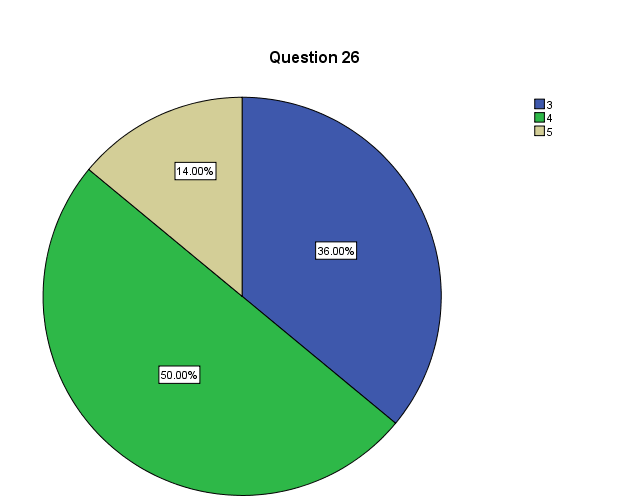
The evaluation process is fair and apposite
Majority of the respondents consider their evaluation process fair and ethical. Apposite evaluation process eliminates conflicts within the workplace, thus making the business environment friendly and pleasant.
Table 31: Fair evaluation process.

Employees’ Performance
No matter what position an individual holds communication material is provided to every staff member
In order to have a positive effect of communication, information and communication material should be distributed among all the members at the workplace. The result also shows that more than 38% of the individuals are getting all the information related to their work and their company’s business.
Table 32: Communication material is distributed among all the members.
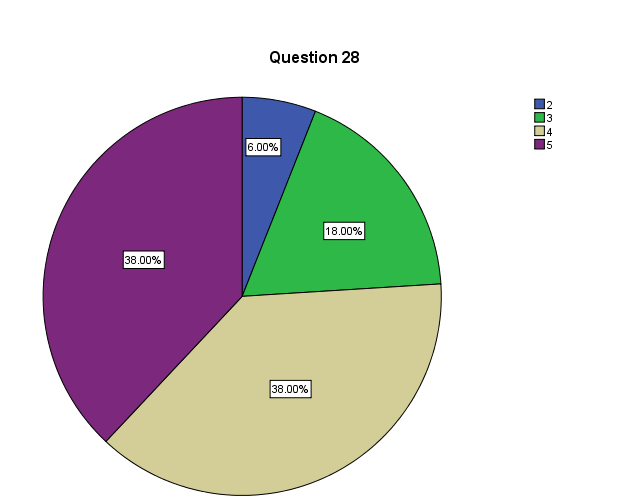
I am highly satisfied with the organization’s communication level
A large portion of respondents is highly contented with their organization’s communication level. Therefore these organizations are having best relationships with their employees are they are the ones that are acquiring higher revenues and moving towards success.
Table 33: Organization’s communication level.
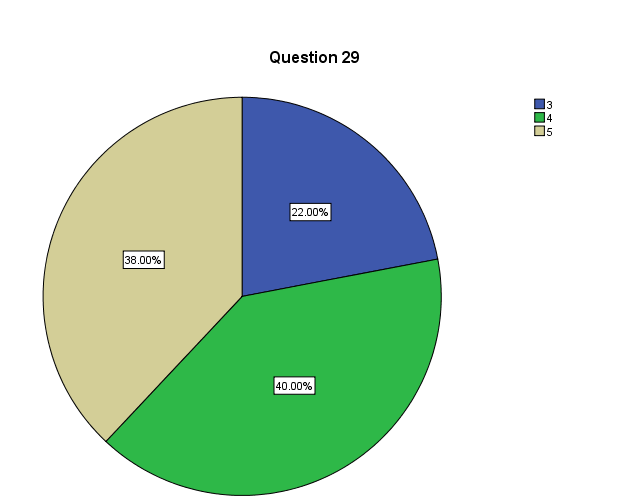
The organization does not support cultural conflicts
It can be observed that most of the respondents are satisfied with their workplace environment and cultural conflicts are not a part of their business culture. As described by Kirizen and Merrier (2008), the cultural dissimilarity often turns out to be a barrier when one assumes that cultural values, attitudes and norms are incorrect if they differ from one’s own culture, which should be eradicated at all levels.
Table 34: Cultural conflicts are not supported.

Creativity can be easily expressed as there is less hierarchy and communication flow is high
Results in Table 35 shows that 50% of the individuals believe that less hierarchy is much better than high hierarchy, as it enable easier communication flow and encourages creativity among the employees and other staff members.
Table 35: Creativity and less hierarchy are supported.

Discussion
The findings of this study are structured in a way that they cover each aspect of the research in a detailed manner. As it has been set out in the conceptual framework, the objective of the present study is not only to investigate the level of communication at workplaces, and how it helps to improve the understanding between the employer and the employees within the organization but also to explore how employees’ and corporate performance is affected by communication as well which contribute significantly towards achieving higher benefits for the company.
In this section of the report, the findings from the present study are discussed in light of the research questions that are set in the earlier chapter of this report to form in light of the relevance with the existing literature provided in this report.
The second research question that is laid out is aimed at exploring the perception of both employees and employers regarding verbal and non-verbal communication within the organizations. This has been tested out in this study by carrying out descriptive analysis on the collected data. The results clearly show that there is a positive relationship between the affect of communication and corporate performance.
As Stanley Deetz Theory suggests that communication is the central procedure through which the sub-ordinates and managers share information, build relationships, express ideas, give suggestions and construct organizational philosophy and principles (Berger 2008).
Studies provided by Champoux (2011) clearly indicate that verbal and non-verbal communication has a positive impact upon the performance of the organization as a whole. A good communication process helps to drive higher economy and global relationship between and within the organizations. These present studies also verify the first hypothesis, which is about the positive impact of verbal and non-verbal communication on corporate performance. The findings clearly prove that communication within an organization has a positive relationship with the performance of the business environment.
The next step in the present study is to evaluate how communication has a positive influence upon employee’s performance. This has been discussed in several previous studies such as Berlo, Gerbner and Schramm’s model, and it is considered as one of the most predominant factor, which positively affect the performance of employees. The present study reveals that the individuals highly acknowledge effective communication within their organizations, as it improves their performance and they feel more committed to their work when they are provided with accurate information about their tasks such as updated instructions, accurate deadlines and feedbacks.
This has also been emphasized by Bonitz (2007), who believes that communication barriers should be eliminated and friendly management and approachable environment should be enabled to the employees in order to encourage the individuals to share their ideas and work together to make their organization to reach to its full potential.
The fourth and fifth questions are the most significant questions as they are related with the hypothesis. It aims upon investigating the impact of communication upon corporate performance, and how it has a positive perception upon employees’ feedback. The present study clarifies that communication plays a predominant role in structuring of organization policies, procedures, activities, objectives and strategies. The results of the survey also show that employee responses are also supporting the situation, and they also believe that communication is a perfect source of growth. Good communication eliminates conflicts and boost up the morale of the employees.
Summary
The findings presented in this chapter support two hypothesis set out for the present study sufficient evidence has been collected from the primary tool designed and implemented for this study. The implications of these results are discussed in the next chapter to conclude the study.
Conclusions and Recommendations
Conclusions
The objective of the study has been addressed by carrying out a comprehensive study that is just descriptive in nature. The purpose of the study has been to investigate effect of communication within organizations and projects. The study has successfully been able to discuss and test out two research hypotheses, which were set out in the conceptual framework of the report. The results from the present study are summarized in the following.
Verbal Communication and Corporate Performance
Successful verbal communication always has a positive impact upon the corporate performance. The effective actions taken by senior executives and other staff members take place almost entirely with the help of verbal communication. It builds relationships and construct emotional tones among the co-workers that ultimately establish the performance culture of the organization.
As described in literature review, if verbal communication is not effectual and valuable then coordination among the employees is disturbed, employee-manager relationships suffer, decision-making is affected and eventually productivity plunges. Balanced oral and written communication within an organization helps generate more productive conversational environments, minimizes defensiveness and maximizes openness and creativity, ultimately increasing corporate performance.
Non-Verbal Communication and Corporate Performance
Non-verbal communication is another imperative medium for the success of a positive business environment. If the managers and subordinates show a true responsiveness to non-verbal cues, the corporate would have a better chance to be successful, as it will be an open, trustworthy and confronting team as a whole. Distance, orientation, posture, gestures, facial expression, eye contact, space and many other dynamic features of non-verbal communication helps increase the level of productivity within the organization and builds effective employee-customer relationships (Perkin 2008).
Affect of Communication and Employee’s Performance
Chapter Two of the current research report also highlights that positive communication business culture and effectual employee communication bolster employees’ recognition with their organizations that enhances an organization’s economic performance and prolonged accomplishment. Communication also helps to avoid legal conflicts at the workplace. According to Carl, “The most effective strategies for preventing employee problems involve good communication with subordinates and providing clear expectations for performance” (Bonitz 2007).
Employee’s Feedback and Communication Influence
The art of communication and providing feedback to employees is a key element for business success. The employees’ feedback fortifies the working relationship between the co-workers and the employer. The feedback provides the employee an opportunity to interact directly with his CEO.
The employee has an advantage to air grievances in a proficient and constructive manner. Effective feedback also helps to increase the morale of the employee and enables motivation to fulfil their tasks. Every organization should create a working environment where the employees can enjoy what they work, have a feeling of purpose, feel proud in what they work and can accomplish their potential to its full extent.
This research study has discovered that both the research methodology and the results are conveying the similar meaning regarding communication approach. The results of the current study are coherent with the Stanley Deetz Theory and Communications Models of Berlo, Schramm’s and Gerbner’s. The study and findings both have demonstrated that employees’ performance and corporate efficiency is improved by adopting appropriate communication processes. The present results have promised implications for supporting teamwork, making feasible working environment, enhancing employees’ performance and boosting financial performance by implementing effective communication process within the workplace.
Recommendations for Future Study
One of the limitations of the present study is that it is general in nature without any focus on a particular organization. For any future study, it is recommended to select different organizations and evaluate its communication process. In addition, communication in third world countries organizations can also be targeted and can be compared with developed countries organization. This would make it more elaborative and precise. This will allow to extend the scope of such study and to discuss the trends among developed and underdeveloped business world.
List of References
Agarwal, R., 2008. Organization and Management. New Delhi: Tata McGraw Hill.
Anon., 2011. Types of Communication. In Champoux, J. Organizational Behavior: Integrating Individuals, Groups and Organizations. New York: Routledge. pp.323-24.
Berger, K.B., 2008. Employee/Organizational Communication. Web.
Bonitz, C., 2007. Communication in the Workplace. Hudson Valley Business Journal.
Dalton, M. and Hoyle, G.D., 2009. The Importance of Communication. In Marie Dalton, D.G.H. Human Relations. Mason, OH: Cengage Learning Inc. pp.94-97.
Derks, D. and Bakker, A., 2010. Impact of E-mail Communication on Organizational Life. Journal of Psychosocial Research on Cyberspace.
Deviny, K., 2010. Schramm’s Model of Communication. Web.
Fielding, M., 2006. In Fielding, M. Effective Communication in Organizations; Third Edition. Capetown: Juta and Co. Ltd. pp.119-25.
Fiske, J., 1990. Gerbner’s Model. In Fiske, J. Introduction to Communication Studies; Second Edition. New York: Routledge Publishers. pp.24-30.
Foss, A.K. and Littlejohn, W.S., 2008. Theories of Human Communication; Ninth Edition. Belmont, CA: Cengage Learning Inc..
Goodall, S., 2010. Communication as a Transactional Process. In Goodall, S. Business and Professional Communication in the Global Workplace. Boston: Cengage Learning. p.36.
Guffey, E.M., 2008. Business Communication, Process and Product 6th Edition. Mason OH: Cengage Learning Inc.
Hayward, A.B., 2005. Relationship between employee performance, leadership and emotional intelligence in a South African Organization. Thesis. Rhodes University.
Hhan, M., 2010. Overcoming Communication Barriers in Organizations. Web.
Hussain, K., 2009. Effects of E-mail use on other communication media among administrators in Malaysia and United Kingdom; A Comparative Study. Research Report. University of Teknikal Malaysia.
Krizan, A.C. and Merrier, P., 2008. Business Communication; 7th Edition. Quebec: Cengage Learning Inc.
Kuhnen, M.C., 2010. Feedback, Self-Esteem and Performance in Organizations∗. Research Report. New York: New York University of Neural Science.
Kushal, S.J., 2010. Non Verbal Aspects of Communication. New Delhi: FK Publishers.
Luo, Y. and Shenkar, O., 2006. The multinational corporation as a multilingual community: Language and organization in a global context. Journal of International Business Studies .
Matveev, A.V., 2002. Theory Of Communication and Applied Communication. London: Business and Law Publishing.
Miller, K., 2009. Communication in Classical Approaches. In Miller, K. Organizational Communicaion; approaches and processes. Boston: Cengage Learing Inc. pp.28-30.
Mortensen, C, David., 1972. Communication the Study of Human Communication. Communication Models. New York: McGraw Hill Book Co.
Mukherjee, K., 2009. Forms of Communication. In Mukherjee, K. Principles of Management 2E. New Delhi: Tata McGraw Hill. pp.175-77.
Narula, U., 2006. Functions of Communication Models. In Narula, U. Handbook of Communication; Models, Perspectives and Strategies. New Delhi: Atlantic Publishers. pp.31-32.
Perkin, P., 2008. The Impact of Non-Verbal Communication. Forbes.
Punamarpi, 2011. Communication: Initial Significance of Brand Image recognition. Web.
Thomson, S., 2007. Importance of Communication in an Organization. Web.